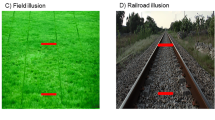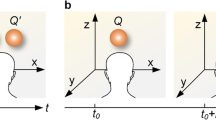Abstract
Constructivism undermines realism by arguing that experience is mediated by concepts, and that there is no direct way to examine those aspects of objects that belong to them independently of our conceptualizations; perception is theory-laden. To defend realism one has to show first that perception relates us directly with the world without any intermediary conceptual framework. The result of this direct link is the nonconceptual content of experience. Second, one has to show that part of the nonconceptual content extracted from the environment correctly represents features of mind independent objects. With regard to the first condition, I have argued elsewhere that a part of visual processing, which I call “perception,” is theory-neutral and nonconceptual. In this paper, facing the second demand, I argue that a part of the nonconceptual content of perception presents properties that are the properties of mind independent objects. I claim first that nonconceptual content is the appropriate level of analysis of the issue of realism since it avoids the main problems besetting various types of analysis of the issue at the level of beliefs about the world. Then I claim that a subset of the nonconceptual content presents features of objects in the environment as they really are.
Similar content being viewed by others
References
Bermudez J.L. (1995). Nonconceptual content: From perceptual experience to subpersonal computational states. Mind and Language 10(4): 333–369
Bermudez J.L. (2003). Thinking without words. Oxford, Oxford University Press
Bickhard M.H. (2000). Dynamic representing and representational dynamics. In: Dietrich E., Markman A.B. (eds) Cognitive dynamics. Mahwall NJ, Lawrence Erlbaum, pp. 31–51
Block N. (1996). How can we find the neural correlate of consciousness. Trends in Neuroscience 19, 456–459
Bonjour L. (2003). A version of internalist foundationalism. In: Bonjour L., Sosa E. (eds) Epistemic justification: Internalism vs. externalism, foundations vs. virtues. Oxford, Blackwell Publishing
Bruce V., Green P.R. (1993). Visual perception: Physiology, psychology and ecology (2nd ed). Hillsdale, NJ, Lawrence Erlbaum
Davidson D. (1983). A coherence theory of truth and knowledge. In: Dieter H. (eds) Kant oder Hegel. Stuttgart, Klett-Cotta
Dehaene S., Kerszberg M., Changeux J.P. (1998). A neuronal model of global workspace in effortful cognitive tasks. Proceedings of the National Academy of Science, USA 95: 14529–14534
Dennett D. (1978). Brainstorms. Montgomery, VT, Bradford Books
Dretske F. (1993). Conscious experience. Mind 102(406): 263–283
Ferster D. (1981). A comparison of binocular depth mechanisms in areas 17 and 18 of the cat visual cortex. The Journal of Physiology 311, 623–655
Fodor J. (1975). The language of thought. Cambridge, MA, The MIT Press
Fodor J. (1994). The elm and the expert. Cambridge, MA, The MIT Press
Glover S. (2004). Separate visual representations in the planning and control of action. Behavioral and Brain Sciences 27(1): 3–79
Goodale M.A., Milner D.A. (1992). Separate visual pathways for perception and action. Trends in Neuroscience 15, 20–25
Goodale M.A., Milner D.A. (2004). Sight unseen. Oxford, Oxford University Press
Haugeland, J. (1998). Having thought. Harvard University Press.
Hollingworth A., Henderson J.M. (2002). Accurate visual memory for previously attended objects in natural scenes. Journal of Experimental Psychology: Human Perception and Performance 28(1): 113–136
Hollingworth A., Williams C., Henderson J.M. (2001). To see and remember: Visually specific information is retained in memory from previously attended objects in natural scenes. Psychonomic Bulletin & Review 8(4): 761–768
Karmiloff-Smith A. (1992). Beyond modularity: A developmental perspective on cognitive science. Cambridge, MA, The MIT Press
Kitcher P. (2001). Real realism: The Galilean strategy. Philosophical Review 110(2): 151–199
Lamme V.A.F. (2000). Neural mechanisms of visual awareness: A linking proposition. Brain and Mind 1, 385–406
Lamme V.A.F. (2003). Why visual attention and awareness are different. Trends in Cognitive Sciences 7(1): 12–18
Markie P.J. (2004). Nondoxastic perceptual evidence. Philosophy and Phenomenological Research LXVIII(3): 530–554
Mandelbaum M. (1964). Philosophy, science, and sense perception. Baltimore, MD, The Johns Hopkins University Press
Marr D. (1982). Vision: A computational investigation into human representation and processing of visual information. San Francisco, CA, Freeman
McDowell, J. (1994). Mind and world. Harvard University Press.
Norman J. (2002). Two visual systems and two theories of perception. Behavioral and Brain Sciences 25, 73–144
Poggio G.F., Talbot W.H. (1981). Mechanisms of static and dynamic stereopsis in foveal cortex of the rhesus monkey. The Journal of Physiology 315, 469–492
Putnam H. (1980). Models and reality. Journal of Symbolic Logic 45, 464–482
Putnam H. (1981). Reason, truth and history. Cambridge, Cambridge University Press
Pylyshyn Z. (2003). Seeing and visualizing. Cambridge, MA, The MIT University Press
Quine W.V.O. (1960). Word and object. Cambridge, MA, The MIT University Press
Quine W.V.O. (1970). On the reasons for indeterminacy of translation. Journal of Philosophy LXVII, 178–183
Raftopoulos A. (1997). Resource limitations in early infancy and its role in successful learning: A connectionist approach. Human Development 40(5): 293–319
Raftopoulos A. (2001a). Is perception informationally encapsulated? The issue of the theory-ladenness of perception. Cognitive Science 25, 423–451
Raftopoulos A. (2001b). Reentrant pathways and the theory-ladenness of observation. Philosophy of Science 68, 187–200
Raftopoulos A. (2006). Defending realism on the proper ground. Philosophical Psychology 19(1): 1–31
Raftopoulos, A. (forthcoming). Perception and cognition: How do psychology and neural science inform philosophy. Cambridge, Mass: The MIT Press, a Bradford Series Book
Raftopoulos A., Müller V. (2006a). The nonconceptual content of experience. Mind and Language 27(2): 187–219
Raftopoulos A., Müller V. (2006b). Deictic codes, object files, and demonstrative reference. Philosophical and Phenomenological Research 72(2): 251–286
Sosa E. (2003). Beyond internal foundations to external virtues. In: Bonjour L., Sosa E. (eds) Epistemic justification: Internalism vs externalism, foundations vs. virtues. Oxford, Blackwell Publishing
Spelke E.S. (1990). Principles of object perception. Cognitive Science 14, 29–56
Stich S.P. (1985). Could man be an irrational animal?. Synthese 64, 115–135
Tye M. (2005). Nonconceptual content, richness and fineness of grain. In: Gendler T., Hawthorne J. (eds) Perceptual experience. Oxford, Oxford University Press
Ulmann A., Richards W. (eds) (1990). Image understanding. Norwood, NJ, Ablex
Vision G. (1997). Problems of vision. Oxford, Oxford University Press
Vision G. (1998). Perceptual content. Philosophy 73, 395–428
Author information
Authors and Affiliations
Corresponding author
Additional information
This paper was mostly written when I was a fellow at the Center of Philosophy of Science in the University of Pittsburgh during the Spring Semester of 2005–2006. A draft of this paper was presented both at the Center’s colloquium and at one of the informal discussion meetings of the fellows. I have very much benefited from the discussion that followed the presentation of the paper and so I would like to thank Gabriele de Anna, Carla Fehr, Malcolm Forster, Lilly Gurova, Nikolay Milkov, and Wang Wei. I am especially indebted to the director of the Center Professor John Norton whose astute comments made me think hard about the issues discussed in the paper. Several of my arguments in Sect. 4 are the result of John’s concerns with the earlier draft of the paper. I would also like to thank the two anonymous reviewers for helping me clarify several points in the paper. Thanks to them (especially the second one) the paper is considerably better than it would have been without them.
Rights and permissions
About this article
Cite this article
Raftopoulos, A. Perceptual systems and realism. Synthese 164, 61–91 (2008). https://doi.org/10.1007/s11229-007-9216-3
Received:
Accepted:
Published:
Issue Date:
DOI: https://doi.org/10.1007/s11229-007-9216-3




